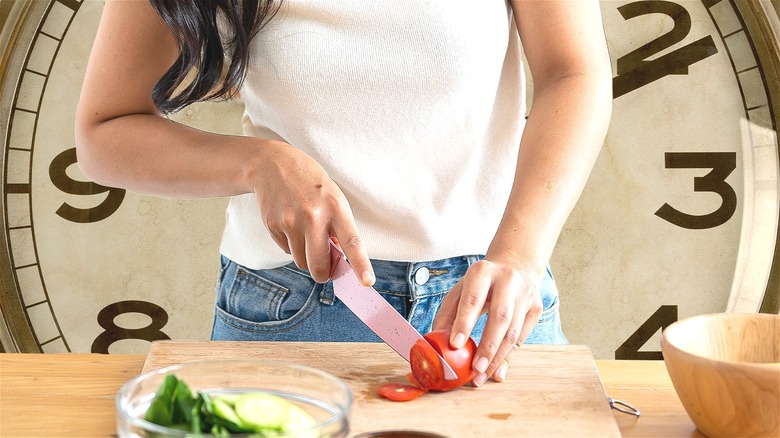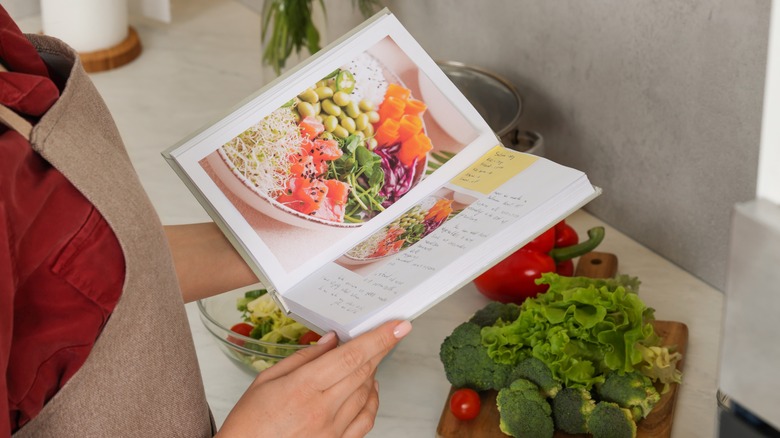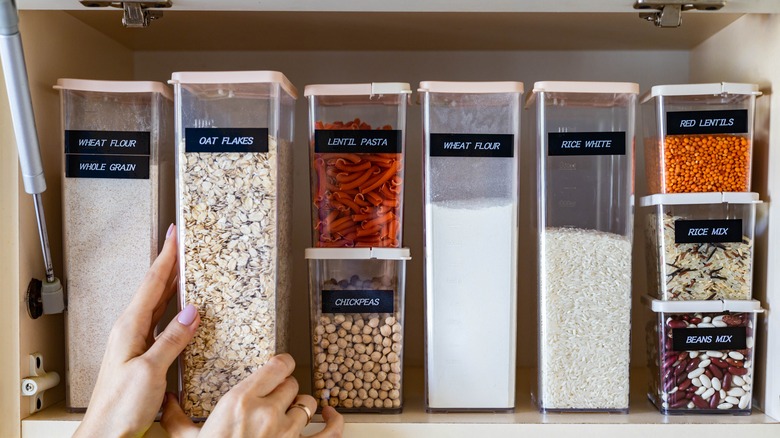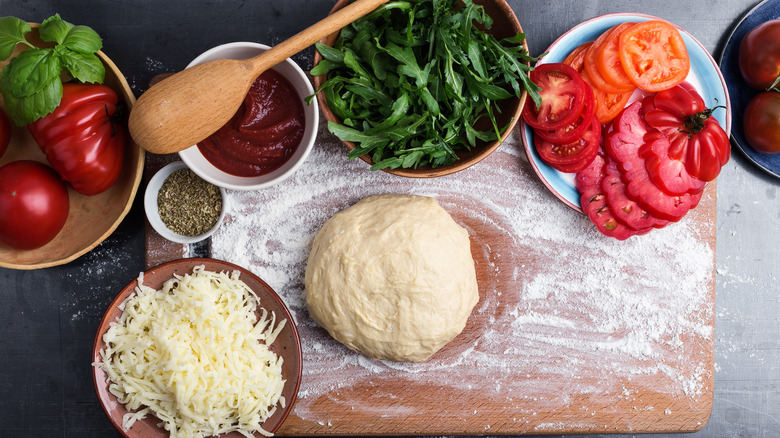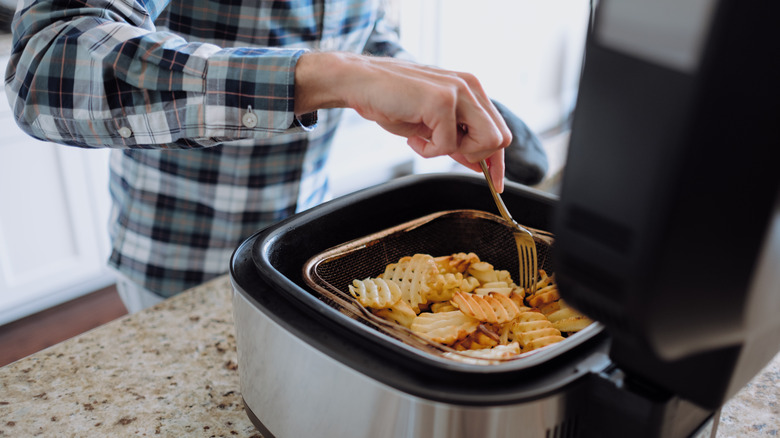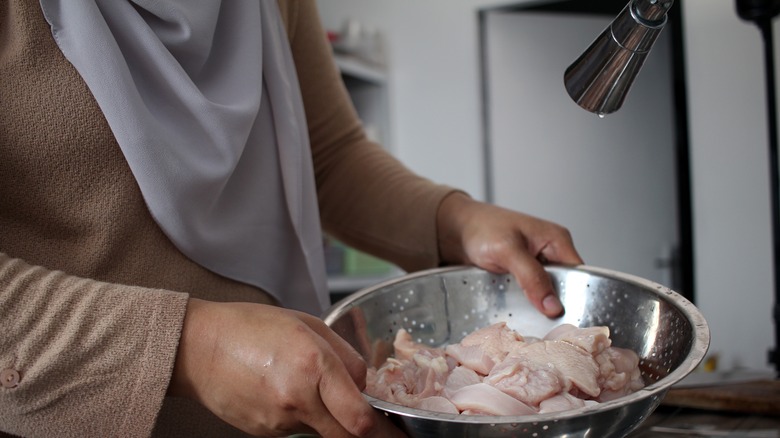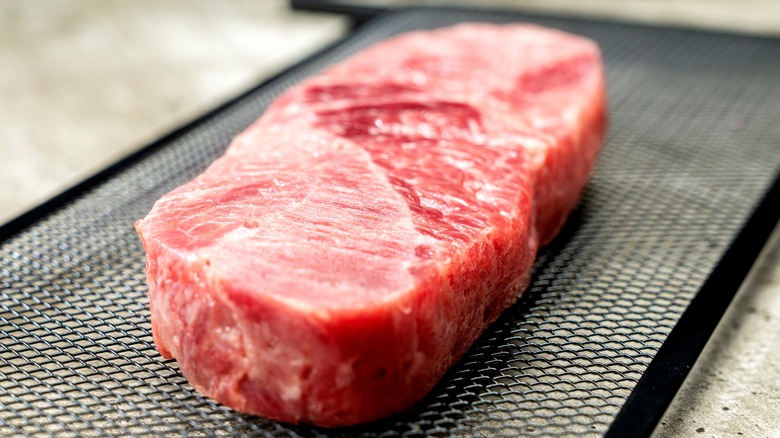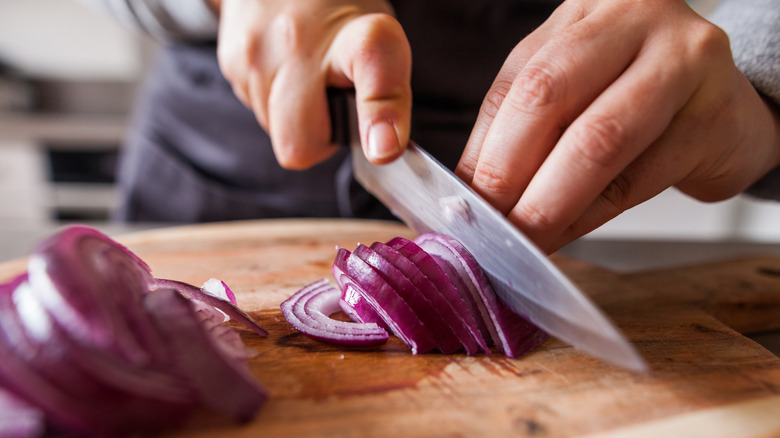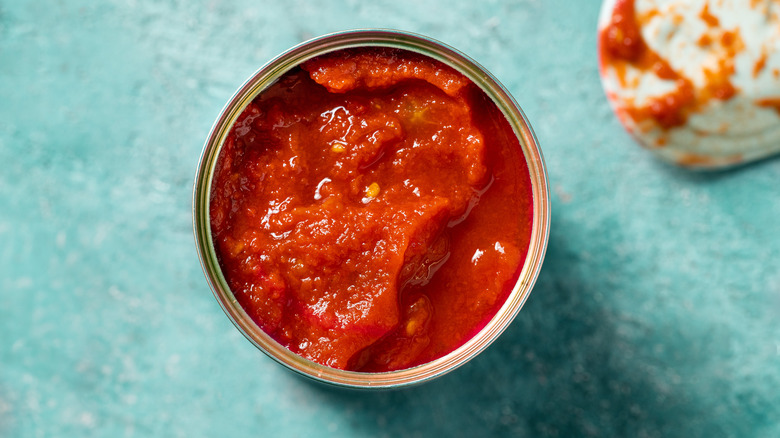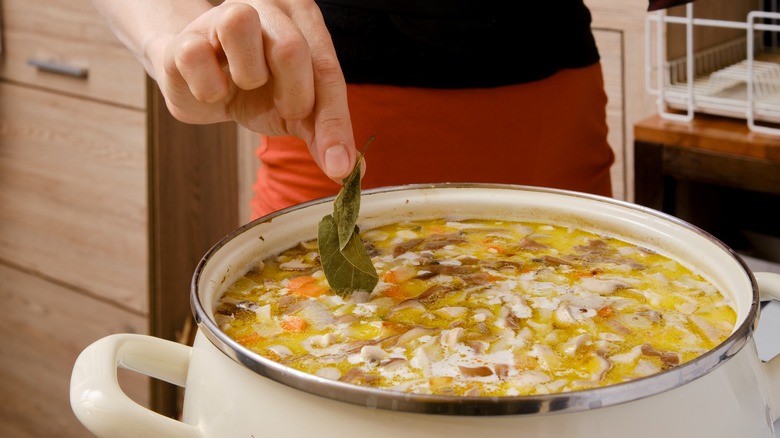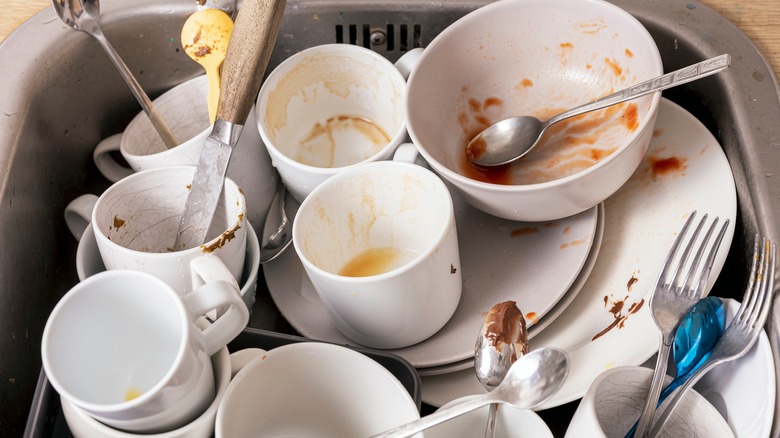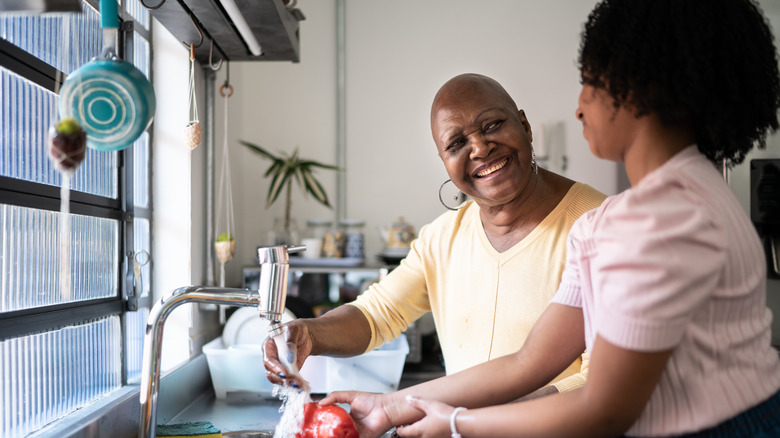12 Tips To Cut Down On Cooking Time
We may receive a commission on purchases made from links.
Cooking at home remains a valuable skill for the average person, and regardless of your reason, it will always boast countless upsides. It'll undeniably be more frugal than instant-ordering burgers from your phone, and you get full control over the dietary factors, from the serving on your plate to the quantities of seasonings. On the other hand, turning raw ingredients into a full main course can eat up a lot of time — and who has that when they're running around for work, family, and otherwise?
Whether you're entertaining last-minute guests, or simply need strategies to resist the siren song of pizza delivery, cutting down on the cook time will factor into such scenarios. Shortcuts can get maligned, often unfairly, as cop-outs. However, convenience doesn't have to come at the expense of nourishing ourselves well. In fact, learning ways to slap together something in a pinch can work our culinary muscles to unexpectedly successful ends. "Not every meal will be a masterpiece," Jessica Formicola, founder of the blog Savory Experiments, told Chowhound. "They serve different objectives and sometimes it's just to get dinner on the table."
For those nights where you're racing to feed a crowd, take these pointers we gathered from recipe developers and cookbook authors to make mealtime a breeze.
Thoroughly read the recipe
An expert probably doesn't need to tell you this, but just to get off on the right foot, let's start with a basic rule of thumb for cooking faster (and in some senses, smarter). Give yourself a chance to carefully review the recipe. Julia Turshen, an acclaimed culinary pro who recently published the cookbook, "What Goes With What," lives by this "time-saving step" to eliminate the guesswork that coulld emerge while cooking. "You have a sense of what the forecast looks like and can plan accordingly," she says, and rightfully so. When you're aware of the directions at hand, you won't need to constantly refresh yourself on the details.
Don't skim — go through each and every ingredient and take stock of the prep work and tasks with an eagle's eye. Otherwise, you might sabotage your progress once you begin doing the cooking for real. In the thick of the action, realizing you forgot to take out a stick of butter to warm on the countertop or neglected lowering the oven temp on your roast chicken will only create problems that could have been prevented. You wouldn't build a piece of IKEA furniture without looking over the instruction manual, right? Give your dinner, dinner party guests, and yourself the same respect.
Maintain a tidy cooking space
How many meals-in-progress have been sidelined because of having to dig for a mixing bowl or misplacing a potato masher? When hunger is on the line, home cooks can avoid this frustrating hindrance when they keep their kitchens immaculately tidy. Invest some effort into carving out spots to put your cookware so once it's time to get the show on the road, you won't struggle tracking down important supplies. Grace Vallo, whose food blog Tastefully Grace boasts over 25,000 followers on Instagram, finds that maintaining a neat space goes hand-in-hand with serving your meal efficiently. "Having a well-organized kitchen with commonly used tools and ingredients within easy reach, reduces stress and speeds up the process," she says.
A mess-free kitchen, generally, is all about routine maintenance. Has clutter accumulated in your pantry, blocking your view of regular necessities? Consider conducting clean-outs regularly so you don't forget about the items you already own. Pots, pans, and cooking utensils including wooden spoons and tongs, will be much more useful to you when they're stored neatly and visible to the eye. Use food storage containers that are see-through for peak accessibility.
Stay on track with a to-do list
Cobbling together a decently-satisfactory dinner usually connotes that it's something we can wing on the spot, no advance planning necessary. However, it'll pay off in minutes saved if you draft up a to-do list. The reason being, it eliminates unnecessary panic that can arise when you're unsure of what you're supposed to do. Staying proactive with a checklist is also particularly useful for the kind of meals requiring a chronological flow of duties.
"I like to have a list of tasks in the order that they need to be tackled," says Cynthia Christensen, the brain behind the food blog, But First We Brunch. "As each task is completed, I always happily make a big checkmark." For example, if you were preparing a classic spaghetti recipe, you might jot down steps such as chopping the onion and garlic, cooking the ground meat, and boiling a pot of water for the pasta. This could really come in handy for multi-tasking within the dish — say, using a natural break when the meat sauce is simmering to get the noodles bubbling away on the stove.
Organizing your tasks doesn't have to be complicated; a notepad and paper will do, or your phone if you prefer digital organization. Meal-planning apps also offer this feature, albeit with more personalized tools.
Set out all of your ingredients
"Mis en place" is a cooking prep step originating out of professional French kitchens. Despite the sophisticated-sounding term (did you know Anthony Bourdain always completed this pre-cooking ritual?), the tactic is incredibly approachable to cooks on a tight deadline. Essentially, you round up whatever components are needed to make your recipe, ahead of assembling the actual dish itself. Depending on the meal, this part of the process could call for an additional bit of labor — say, if your recipe orders dicing up a zucchini or concocting a seasoning mixture that's added later on.
By having the ingredients themselves on standby, you're spending less energy later since the essentials will be ready to go into the pan or oven as directed. "Gathering all of your ingredients together before you even start is the best way to ensure success in a recipe," Cynthia Christensen emphasizes. If you're on a mission to bring your cooking process to an all-time minimum, retrieve your essentials (yes, all of them). It's going to be a big help for beating the clock, given that manically rummaging for a box of baking soda can seriously interfere with your efforts to eat sooner rather than later, according to Jessica Formicola.
Good tools can quickly produce results
Ever hear the phrase "cook smarter, not harder?" Assuming you're already familiar with time-saving technologies like microwaves and toasters, it still bears repeating that proper appliances are your friend for cutting cook time. Where it would normally be a hassle to prepare beans out of a bag, tools (in this case, a pressure cooker) can get them hot and ready for your burrito bowl in a briefer window.
Food processors are an excellent tool for mincing ingredients down to tiny bits — in Cynthia Christensen's case, for combining butter and flour for flaky biscuits. Meanwhile, Jessica Formicola uses them for slicing bell peppers or onions. Those who aren't confident in their chopping abilities can also use a mandolin, too. Nifty gadgets like immersion blenders are supreme for achieving creamy consistencies in sauces and soups, according to Grace Vallo. To char veggies in minutes, Julia Turshen gladly vouches on behalf of the air-fryer for its speedy heating properties. "It makes roasting them so quick and easy and cleanup is way easier than a sheet pan," she said. It is one of the dozens of hacks for many that makes this tool a must on jam-packed weeknights.
Defrost frozen meat by running it under water
Whether it's turkey breast, pork chops, or prime rib, a meat entree never fails to nourish the soul after a strenuous work day. Unfortunately, if you rely on stashing your meat in the freezer, forgetting to let it defrost could throw a wrench in any spur-of-the-moment meal ideas. Thankfully, Cynthia Christensen offers a solution that fast-forwards the waiting game, all the while keeping your cutlet in prime cooking condition. "When I need meat thawed in a pinch, I will place the sealed bag into a container of cold water, with another container filled with water on top of it to keep it submerged," she says. "This will thaw out the meat in 30 minutes to an hour while keeping the temperature in the safety zone."
Should you go with this technique, just be sure to check that your water is cold enough (the temperature should be close to 40 F, and nothing higher than that). You should also make sure that your protein is fully enclosed in the packaging; Christensen recommends trashing the styrofoam holders retailers typically use for packing raw meats and store it in a high-quality freezer bag instead. This will keep out air and maintain the freshness.
Thaw out your meat on a baking sheet
Soaking your ground beef block in a bath is all well and good, but on a chaotic Monday, is it the only method we have at our disposal for taco filling in a flash? Julia Turshen divulged a different — yet no less effective — shortcut to defrosting meat, and it comes courtesy of another fellow food expert, J. Kenji Lopez-Alt. As she explained to Chowhound, take your bag of meat that you're hoping to thaw out. Instead of putting it in water, you lay it out to rest on an aluminum baking sheet. The idea behind this tip is that the metal surface works as a conduit for heat. The heat that the tray soaks in from the surrounding environment helps dissolve the frosted meat, therein warming the protein to room temperature.
Perhaps you want to keep your cookie sheet separate for baking only, which is valid. Buying a thawing plate, which Formicola agreed was well worth the purchase, could come very much in handy for quick defrosting. As a side note, make sure to keep up on your food safety knowledge. It only takes two hours for raw or perishable foods to enter the danger zone, per the U.S. Department of Food and Agriculture, so keeping a watchful eye amid prepping is crucial.
Chopping food smaller trims off cooking time
Growing impatient waiting on that sweet potato hash to finish searing? Assuming you've been in this position before, there's a common sautéing mistake that could be slowing down your culinary attempts. And simply put, it lies in how you're doing the chopping. Foods chopped into bigger chunks (or left whole, in the case of certain cuts of meat) takes longer than finely-diced pieces, since larger morsels force your appliance to work much harder in conjuring heat. Not only does this inconvenience folks on a schedule, but the quality of your ingredients will suffer, whether that's drying out, burning, or failing to prompt the Mailliard Reaction's caramelized crust.
A strong knife (and knife skills) will serve you in swift slicing and dicing, but there's also zero shame in letting equipment section off pieces. Smaller bits also call for spreading them out on your cooking surface, since this ensures the food at hand will cook thoroughly (and in less time) versus cooking crowded together.
Take a shortcut with store-bought goods
Let's be real, not everyone has unlimited hours to whittle away perfecting a homemade pizza dough recipe. In circumstances where you can't afford to waste another minute deliberating on dinner, there's no shame in sourcing some of your essentials that are ready-to-go from the supermarket. Whether it's jarred salsas or pre-grilled chicken strips to dump into pastas or salads, it's just infinitely easier — and eats up less of your day — to incorporate store-bought goods into your cooking. You didn't have to go to the trouble of doing anything by hand, and the amount of time you'll save is demonstrably high.
More often than not, you'll catch experts incorporating convenience items when it comes to their own culinary projects. If you're making orange chicken, you can take a cue from Cynthia Christensen and nuke a packet of vacuum-sealed rice to go with it as a side dish. Instead of simmering soup stock from scratch, prepared versions like Better Than Bouillon (a huge favorite of Julia Turshen's), can immediately deliver richness to your pot by the tablespoon. "I also love sauces and will buy these store bought instead of making from scratch," Jessica Formicola reveals.
Make larger batches
Cutting down your cook time and eliminating the phrase, "What's for dinner?" from your vocabulary is the two-pronged approach for our next tip. Should a quicker culinary endeavor interest you, it would be wise to make larger batches of food. Anybody already going to the effort of whipping up a full course from scratch will find worthwhile to up the portion sizes, since they can be stretched into leftovers. "Doubling recipes and freezing half can provide quick meals for future busy days," Grace Vallo says. This easily shaves off some extraneous labor knowing you won't have to repeatedly slice carrots or mince garlic cloves during the week
With all that being said, what should you be batch-cooking? From what our experts told us, dishes should be a snap to reheat, remaining edible and flavorful following a stint in the fridge or freezer. Soups can last for months in the freezer, explaining why Julia Turshen gravitates toward "anything soupy or stewy." Cynthia Christensen finds joy in scaling up biscuit dough, which she does by pre-forming the rounds to retrieve from the freezer as desired.
Jessica Formicola adores quinoa and all of its versatility. "I make a giant batch at the beginning of the week and then doctor it up depending on the meal, adding different types of spices and seasonings, fresh veggies or making it into a casserole with cheese and proteins," she said.
Don't tackle dirty dishes at the end
After wrapping up a scratch-cooked meal, doing the dishes is usually the last thing on anyone's mind. Take it from the pros, it's a huge mistake to leave your cookware stacked in the sink. Tackling the entire mess in one go is tempting, but more often than not, the work will catch up to you since every pot, pan, and fork is going to require a rinse-down. Additionally, it's overwhelming to confront. "Nothing is more anxiety producing and stressful," says Cynthia Christensen. Worse yet, neglecting to clean them in the moment often makes for a difficult time scrubbing later on.
This is why experts are in firm agreement on "cleaning as you go," which is a four-word phrase that's certain to benefit your goals to cooking faster. Optimizing your time during the cooking itself to handle messes — washing a plate here, a measuring cup there — avoids toiling at the end when you finally get to relax (ideally, when queuing your Netflix playlist). This "keeps the workspace tidy and reduces the cleanup load after cooking which can be daunting," claims Grace Vallo.
Allocate the labor
Another tip dispensed by our experts comes highly recommended for upping the cooking tempo (and appreciating every minute of it to boot). Roping in a best friend or member of your household to commit to the cooking can make the time fly, particularly when there's a job that can be accomplished by each person. Mixing up a gravy, disposing of scraps, and peeling potatoes is a lot for one person to tackle. Split between others, however, it's manageable and consumes less time overall.
Grace Vallo additionally gives a thumb's up to this strategy, albeit with a slight counterpoint. "It can speed things up if tasks are divided properly, like one person prepping while the other cooks," she says, but from her perspective, a larger group might lead to disarray due to unpreparedness. "Too many cooks in the kitchen without clear roles can create delays."
Regardless, so long as the directions are clear, assigning more hands to your casserole is going to pay off with a much earlier sit-down time. Even better, sharing the work can be a blast for families with small children, which Jessica Formicola approves of from her own experience as a parent. "This gives them a life skill, learning how to cook, but also gives me time to talk about their day and spend quality time together," she says.
